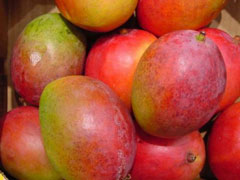


Home
Flowers &
Indoor Plants
Fruits & Nuts
Ornamentals
Vegetables
Special Topics
Resources
Glossary

|
Mango Mangifera indica (mang-gih-fer-ah in-dih-cah)    Click on thumbnails for larger image. |
 |
What about it? The mango is a tropical fruit that can only be grown in Hawaii, southern Florida and southern California in this country, because it will not tolerate any frost. This stately tree is evergreen, tall (40-50 feet) and has large dark green leaves that can grow as large as 2 1/2 feet. The flowers are small and fragrant. The rich, juicy fruits are large in size, growing to 7-8 inches in length. What is it used for? Ripe mangoes are juicy and peach-like, and can be found in northern supermarkets. They can be canned or used for making juice or preserves. They are an ingredient in chutney, and southern gardeners occasionally use them for pickling. Where does it grow? How do we grow it? Mangoes are very intolerant of the cold, and love hot, relatively dry areas. The mango can grow in a variety of soil types, but like most fruit crops, prefer a well-drained soil. Mangoes need full sun. What are its primary problems? Anthracnose, characterized by brown spots on the leaves, cause the leaves to crinkle and die. This disease is common among mangos. Other fungus diseases are powdery mildew, leaf spots, and sooty mold. The mango-hopper is the most serious pest of mango blossoms. How do we harvest and store it? The fruits are generally picked when they begin to change color or after a few ripe fruits have dropped from the tree. After grading and sizing, fruits are packed in single layers and store or transported in refrigerated storage. Before marketing they are ripened for five or six days.
© Copyright, Department of Horticulture, Cornell University. |